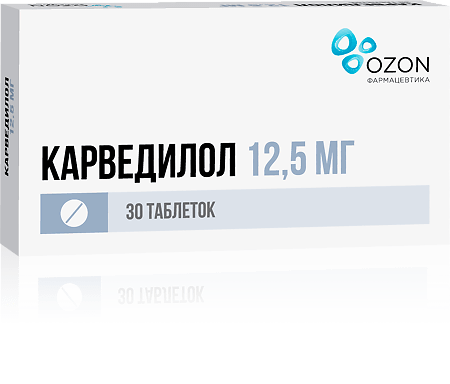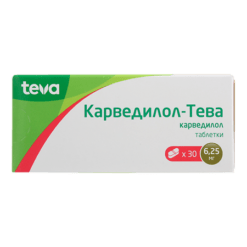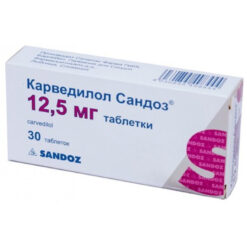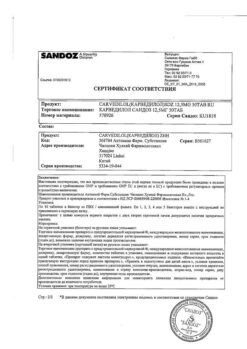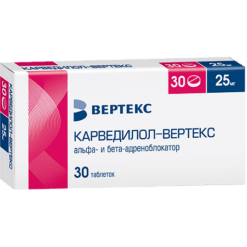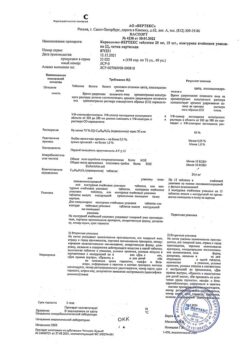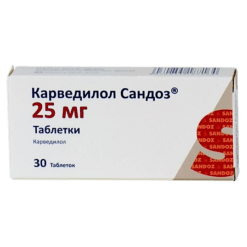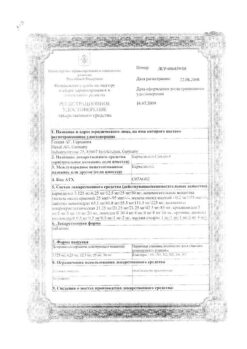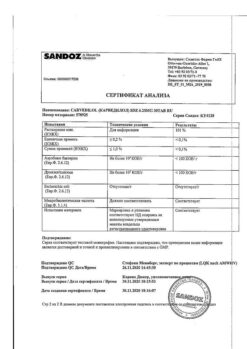No products in the cart.
Carvedilol, tablets 12.5mg 30 pcs
€7.00 €6.39
Description
Pharmacodynamics
Carvedilol blocks alpha-1-, beta-1- and beta-2-adrenoreceptors. It has vasodilatory, antianginal and antiarrhythmic effects. The vasodilatory effect is mainly due to blockade of alpha 1-receptors. Due to vasodilation, it reduces total peripheral vascular resistance (TPRR). It has no sympathomimetic activity of its own and has membrane stabilizing properties. The combination of vasodilation and beta-adrenoreceptor blockade leads to the following effects: in patients with arterial hypertension, the decrease in arterial pressure (BP) is not accompanied by an increase in PPS, peripheral blood flow is not reduced (unlike beta-adrenoblockers). HR decreases insignificantly. In patients with coronary artery disease it has antianginal action. Reduces pre- and post-load on the heart. It has no pronounced effect on lipid metabolism and blood plasma levels of potassium, sodium and magnesium. In patients with left ventricular dysfunction or circulatory insufficiency, it has a favorable effect on hemodynamic parameters and improves the ejection fraction and left ventricular size. It has antioxidant effect by eliminating free oxygen radicals.
Pharmacokinetics
Carvedilol is rapidly and almost completely absorbed after oral administration from the gastrointestinal tract. It is almost completely bound to blood plasma proteins (98-99%). The plasma concentration is proportional to the dose taken. Bioavailability is about 25% due to high metabolism in the liver. Metabolites are formed which have high ability to block beta-adrenoceptors.
Maximum concentration in blood plasma is reached after 1 hour. Half-life period is 6-10 hours.
In elderly patients, the plasma concentration of carvedilol is approximately 50% higher than in younger patients. It is excreted mainly with bile. In patients with impaired liver function the bioavailability may increase to 80%. It penetrates through the placental barrier and is excreted with breast milk. Food slows down absorption of the drug, but does not affect its bioavailability.
Indications
Indications
Arterial hypertension (in monotherapy and combination with diuretics)
Chronic heart failure (as part of combination therapy)
Coronary heart disease: stable angina.
Pharmacological effect
Pharmacological effect
Pharmacodynamics
Carvedilol blocks alpha-1, beta-1 and beta-2 adrenergic receptors. It has a vasodilating, antianginal and antiarrhythmic effect. The vasodilating effect is mainly due to the blockade of alpha 1 receptors. Thanks to vasodilation, it reduces total peripheral vascular resistance (TPVR). It does not have its own sympathomimetic activity, but has membrane-stabilizing properties. The combination of vasodilation and blockade of beta-adrenergic receptors leads to the following effects: in patients with arterial hypertension, a decrease in blood pressure (BP) is not accompanied by an increase in peripheral blood flow, and peripheral blood flow does not decrease (unlike beta-blockers). Heart rate decreases slightly. In patients with ischemic heart disease it has an antianginal effect. Reduces pre- and afterload on the heart. Does not have a pronounced effect on lipid metabolism and the content of potassium, sodium, and magnesium in the blood plasma. In patients with impaired left ventricular function or circulatory failure, it has a beneficial effect on hemodynamic parameters and improves ejection fraction and left ventricular dimensions. Has an antioxidant effect, eliminating free oxygen radicals.
Pharmacokinetics
Carvedilol is rapidly and almost completely absorbed after oral administration from the gastrointestinal tract. It is almost completely bound to blood plasma proteins (98-99%). The concentration in the blood plasma is proportional to the dose taken. Bioavailability is about 25% due to the high degree of metabolism in the liver. This produces metabolites that have a high ability to block beta-adrenergic receptors.
The maximum concentration in blood plasma is reached after 1 hour. The half-life is 6-10 hours.
In elderly patients, carvedilol plasma concentrations are approximately 50% higher than in younger patients. It is excreted mainly in bile. In patients with impaired liver function, bioavailability may increase up to 80%. Penetrates the placental barrier and is excreted in breast milk. Food slows down the absorption of the drug, but does not affect its bioavailability.
Special instructions
Special instructions
Therapy should be carried out over a long period of time and should not be stopped abruptly, especially in patients with coronary heart disease, as this can lead to a worsening of the underlying disease. If necessary, the dose reduction should be gradual over 1-2 weeks.
At the beginning of therapy with carvedilol or when the dose of the drug is increased in patients, especially elderly patients, an excessive decrease in blood pressure may be observed, mainly when standing up. A dose adjustment of the drug is necessary. In patients with chronic heart failure, when selecting a dose, an increase in symptoms of heart failure and the appearance of edema is possible. In this case, the dose of carvedilol should not be increased; it is recommended to prescribe large doses of diuretics until the patient’s condition is stabilized.
Continuous monitoring of the electrocardiogram and blood pressure is recommended while prescribing carvedilol and slow calcium channel blockers, phenylalkylamine derivatives (verapamil) and benzodiazepine (diltiazem), as well as with class I antiarrhythmic drugs.
It is recommended to monitor renal function in patients with chronic renal failure, arterial hypotension and chronic heart failure.
In case of surgery using general anesthesia, the anesthesiologist should be warned about previous therapy with carvedilol.
Carvedilol does not affect the concentration of glucose in the blood and does not cause changes in the glucose tolerance test in patients with non-insulin-dependent diabetes mellitus.
Avoid drinking ethanol during treatment.
Patients with pheochromocytoma should be prescribed alpha-blockers before starting therapy.
Patients wearing contact lenses should be aware that the drug may cause a decrease in tear production.
It is not recommended to drive a car at the beginning of therapy and when increasing the dose of carvedilol. You should refrain from other activities that require high concentration of attention and rapid psychomotor reactions.
Active ingredient
Active ingredient
Carvedilol
Composition
Composition
1 tablet contains:
active ingredient: carvedilol 12.5 mg
Contraindications
Contraindications
Hypersensitivity to carvedilol or other components of the drug,
acute and decompensated chronic heart failure,
requiring intravenous administration of inotropic agents,
severe liver failure,
atrioventricular block stage II-III,
severe bradycardia (less than 50 beats/min),
sick sinus syndrome,
arterial hypotension (systolic blood pressure less than 85 mm Hg),
cardiogenic shock,
bronchial asthma,
chronic obstructive pulmonary disease,
age under 18 years (efficacy and safety have not been established).
With caution
Bronchospastic syndrome, chronic bronchitis, pulmonary emphysema, Prinzmetal angina, thyrotoxicosis, occlusive diseases of peripheral vessels, pheochromocytoma, psoriasis, renal failure, first degree atrioventricular block, extensive surgical interventions and general anesthesia, diabetes mellitus, hypoglycemia, depression, myasthenia gravis.
Side Effects
Side Effects
From the central nervous system: headache, dizziness, syncope, muscle weakness (usually at the beginning of treatment), sleep disturbance, depression, paresthesia.
From the cardiovascular system: bradycardia, orthostatic hypotension, angina pectoris, atrioventricular block, rarely “intermittent” claudication, disorder
peripheral circulation, progression of heart failure.
From the gastrointestinal tract: dry mouth, nausea, abdominal pain, diarrhea or constipation, vomiting, increased activity of liver transaminases.
From the hematopoietic organs: thrombocytopenia, leukopenia.
From the urinary system: severe renal dysfunction, edema.
Allergic reactions: allergic skin reactions (exanthema, urticaria, itching, rashes), exacerbation of psoriatic rashes, sneezing, nasal congestion, bronchospasm, shortness of breath (in predisposed patients).
Other: flu-like syndrome, pain in the extremities, decreased lacrimation, weight gain.
Interaction
Interaction
Carvedilol may potentiate the effect of other concomitantly taken antihypertensive drugs or drugs that have a hypotensive effect (nitrates).
When carvedilol and diltiazem are used together, cardiac conduction disturbances and hemodynamic disturbances may develop.
When carvedilol and digoxin are taken simultaneously, the concentration of the latter increases and the atrioventricular conduction time may increase.
Carvedilol may potentiate the effect of insulin and oral hypoglycemic agents, and the symptoms of hypoglycemia (especially tachycardia) may be masked; therefore, regular monitoring of blood sugar levels is recommended in patients with diabetes mellitus.
Inhibitors of microsomal oxidation (cimetidine) enhance, and inducers (phenobarbital, rifampicin) weaken the hypotensive effect of carvedilol.
Drugs that reduce the content of catecholamines (reserpine, monoamine oxidase inhibitors) increase the risk of developing arterial hypotension and severe bradycardia.
With simultaneous use of cyclosporine, the concentration of the latter increases (adjustment of the daily dose of cyclosporine is recommended).
Concomitant administration of clonidine may potentiate the antihypertensive and heart rate-lowering effects of carvedilol.
General anesthetics enhance the negative inotropic and hypotensive effect of carvedilol.
Overdose
Overdose
Symptoms: decreased blood pressure (accompanied by dizziness or fainting), bradycardia. Shortness of breath may occur due to bronchospasm and vomiting. In severe cases, cardiogenic shock, respiratory failure, confusion, and conduction disturbances are possible.
Treatment: it is necessary to monitor and correct vital signs, if necessary, in the intensive care unit. Treatment is symptomatic. It is advisable to use intravenously m-anticholinergic agents (atropine), adrenergic agonists (epinephrine, norepinephrine).
Storage conditions
Storage conditions
Store in a dry place, protected from light, at a temperature not exceeding 25° C.
Shelf life
Shelf life
3 years.
Manufacturer
Manufacturer
Ozon, Russia
Additional information
| Shelf life | 3 years. |
|---|---|
| Conditions of storage | Store in a dry place, protected from light, at a temperature not exceeding 25 ° C. |
| Manufacturer | Ozon, Russia |
| Medication form | pills |
| Brand | Ozon |
Other forms…
Related products
Buy Carvedilol, tablets 12.5mg 30 pcs with delivery to USA, UK, Europe and over 120 other countries.

